Are you a Floridian who finds it difficult to discover flowers that will blossom in the midst of summer’s extreme heat and humidity?
The good news is that there are plenty of choices that are not just heat-tolerant but also have year-round blooms! This post features our top picks for year-round blooming flowers for Florida flower gardens!
1. Mexican Heather

Scientific Name: Cuphea hyssopifolia
Plant Type: Perennial / Annual
Plant Size: 1-2 feet tall
Sun Exposure: Full sun to partial shade
Mexican Heather is a tiny shrub that grows well in a range of soil types, as long as the soil drains properly. As long as there isn’t a protracted drought, it can withstand the intense heat and humidity of Florida and thrive without regular watering. This plant does not like even a small amount of cold, so some grow it as an annual.
However, if the weather continues warm enough, Mexican Heather will produce an abundance of tiny, six-petaled pink, purple, lavender, or white blooms all year long, with large clusters in the autumn and summer.
2. Begonia
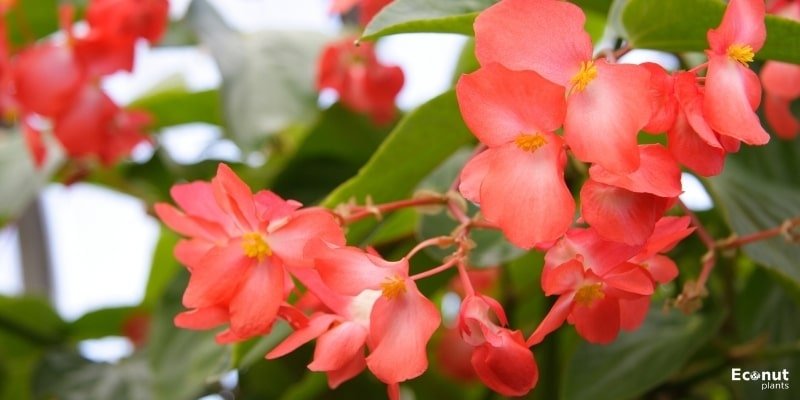
Scientific Name: Begonia
Plant Type: Perennial in Florida
Plant Size: 1-1.5 feet tall
Sun Exposure: Shade to partial shade
In the summer and autumn, begonias typically blossom. Due to their exceptional resilience, flowers bloom almost year-round in Florida due to its generally warm climate. Begonias do not like temperature fluctuations, which is their only drawback.
It is therefore possible that they will not survive a very strong winter cold snap. Consequently, it could be wise to place your begonias in pots that you can keep warm over the winter. However, begonias will repay you with season-long blooms if you plant them in a climate they adore.
3. Firespike

Scientific Name: Odontonema cuspidatum
Plant Type: Annual / Perennial
Plant Size: 1.5-2 feet tall
Sun Exposure: Full sun
The towering, spiky prominences known as firespike blooms have several filaments that branch off of the centre spire. They have a fragile appearance, yet they are actually rather durable and robust. They can be a variety of colours of red, from burgundy to crimson. The leaves have strong ribbing, a deep green colour, and a robust aspect overall.
For all types of firespikes, autumn and summer are the most usual times for them to bloom. However, this plant grows well as a perennial or annual, so depending on the climate cycle and whether you grow it in your outside garden or in a container, you might easily have flowers all year round.
4. Ixora
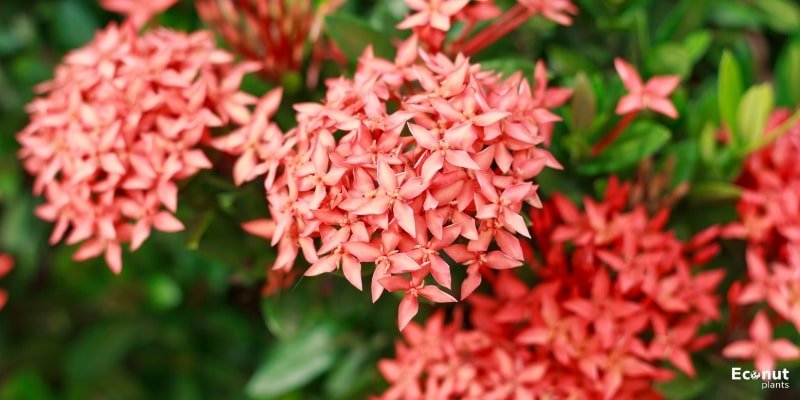
Scientific Name: Ixora spp.
Plant Type: Perennial
Plant Size: 3-7 feet tall
Sun Exposure: Full sun to partial shade
The evergreen flowering bush Ixora has huge, deep green leaves and produces rather large, generally reddish-orange blossoms. They also produce black or purple fruits. Ixora plants will blossom as long as the temperature is over fifty degrees.
You can attempt to shield this plant from cold weather with a covering if you believe there may be a hint of a cold weather trend in the future, but they are typically a little too large for that. Alternatively, certain cultivators sow Ixora in a container and bring it inside during cold spells.
5. Night Blooming Jasmine

Scientific Name: Cestrum aurantiacum
Plant Type: Shrub
Plant Size: 5-150 feet tall
Sun Exposure: Dappled sun to partial shade
This woody perennial, which is native to the tropics, can grow to be fairly large. Colder-temperature gardens can find it, as it dies back with every frost. Nothing grows as tall in these chilly climes.
If enough mild weather persists, it will continue to bloom into the fall, spring, and summer, and maybe into the winter.
Particularly at night, the trumpet-shaped, extremely fragrant blossoms arrive in clusters of bright orange or yellow.
6. Plumbago

Scientific Name: Plumbago auriculata
Plant Type: Perennial / Annual
Plant Size: 6-15 feet tall
Sun Exposure: Full sun to partial shade
The beautiful, velvety blossoms of plumbago have four or five petals. They resemble Phlox quite a bit. This plant is easily trained to climb fences and trellises, but it also grows nicely in containers or as a hedge.
Usually measuring between one and three inches, the tube-shaped blossoms come in blue, light pink or white hues. Make sure you provide enough space when planting plumbago if you don’t intend to prune it.
7. Vinca
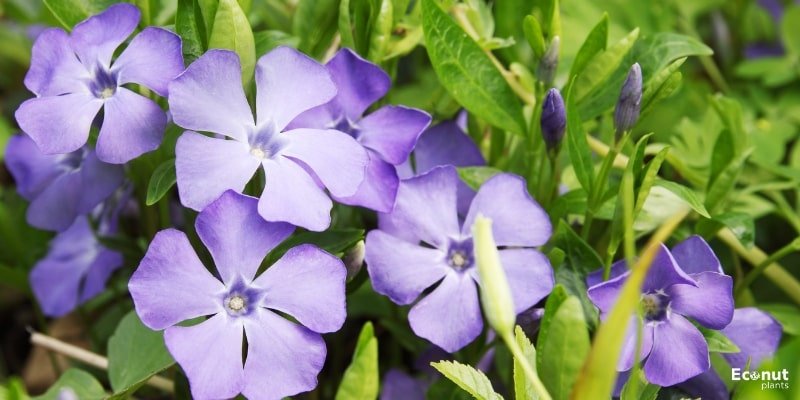
Scientific Name: Catharanthus roseus
Plant Type: Perennial / Annual
Plant Size: 0.5-4 feet tall
Sun Exposure: Full sun to partial shade
The plant C. roseus is also known as the Madagascar Periwinkle Plant. It is also known by the names Vinca, Running Myrtle, and other names. It’s an annual plant that perishes in the frost in frigid climates.
Because vinca does not wither in warm temperatures, its enduring flowers can last all year in Florida’s tropical climate. Therefore, you can grow vinca as a container plant and bring it inside when it gets chilly if you’re worried that it might get too cold where you live.
The plant produces eye-catching clusters of yellow, pink, white, and purple tubes as its blooms.
8. Salvia

Scientific Name: Salvia spp.
Plant Type: Perennial / Annual
Plant Size: 1-3.5 feet tall
Sun Exposure: Full sun to partial shade
There are numerous types of salvia, which means that it comes in a variety of hues, such as white, red, purple, blue, or pink. Long petals and a tubular shape characterize the deeply cupped flowers.
Even in a severe hurricane season with a lot of rainfall, they should thrive because they require well-draining soil and can withstand the occasional storm floods.
In Florida’s generally warm climate, salvia also blooms three times a year, so both you and the pollinators in your region will be able to enjoy flowers all year long!
9. Petunias

Scientific Name: Petunia spp.
Plant Type: Annual
Plant Size: 0.5-1.5 feet tall
Sun Exposure: Part sun to full sun
The term “petunia” comes from the Tupi-Guarani word “petun,” which translates approximately to “worthless tobacco plant.” Still, gardeners adore this plant because of its vibrant blossoms. There are numerous variations, some of which are hybrids.
Three primary groups of these hybrids exist, each with a unique flower size and growth habit. Large flowers, up to four inches wide, are characteristic of grandiflora hybrids. Multiflora hybrids feature more flowers but a smaller flowering plant. Since their stems slope downward, cascading hybrids are perfect for ground covering or basketry.
10. Oleander
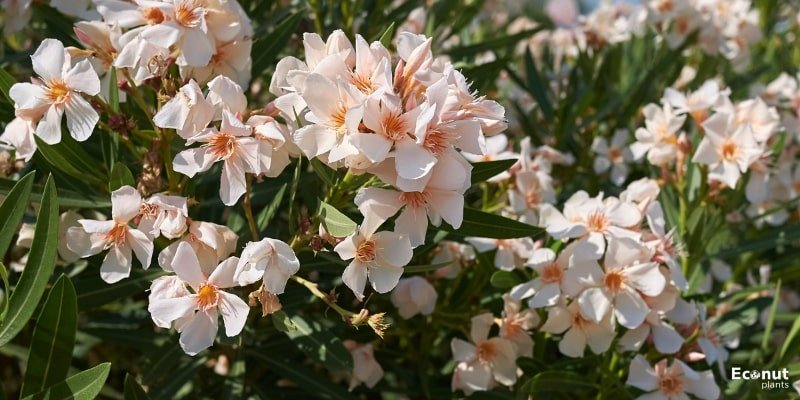
Scientific Name: Nerium oleander
Plant Type: Shrub
Plant Size: 6-20 feet tall
Sun Exposure: Full sun to partial shade
Most of the country’s oleander shrubs are houseplants since they are fairly sensitive to temperatures below freezing. Oleander, on the other hand, can withstand the winters in Florida, where there is an abundance of sunshine and temperatures that usually stay just above freezing. In fact, the blooms can often last throughout the year.
Orange, apricot, white, pink, lilac, red, purple, salmon, or yellow are some of the colour variations of this shrub’s flowers. All of them have five or four petals, and they are funnel-shaped, usually measuring two or three inches across.
11. Lantana

Scientific Name: Lantana spp.
Plant Type: Perennial / Annual
Plant Size: 1-6 feet tall
Sun Exposure: Full sun
Lantana may take over your garden and possibly even your house if it is allowed to grow uncontrolled. Since it thrives in tropical environments, Florida’s warmest and mustiest regions should provide the ideal home. Its ideal growing conditions are full light and well-draining soil. When it becomes established, you’ll need to use pruning shears to prevent it from taking over your space.
Numerous cultivators offer a wide selection of blossom colours, including purple, lavender, orange, pink, gold, yellow, and white. Blooms have a long blooming period and display long, tubular flowers with a potent, sweet scent.
In Florida’s warmest months, lantanas will put on a show and display their year-round blooming blossoms. Lantanas are incredibly resilient and may live for a very long time in hot, dry regions.
12. Hibiscus

Scientific Name: Hibiscus spp.
Plant Type: Perennial
Plant Size: 2-6 feet tall
Sun Exposure: Full sun
Hibiscus comes in a wide range of variations, including some hybrid species. Hibiscus has a wide range of appearances and growing preferences because of its numerous variations.
It’s important to water thoroughly without allowing the soil to get too soggy. Hibiscus can withstand quite a bit of moisture in the soil, but if it isn’t allowed to occasionally dry out, mould growth may occur.
When summer arrives, well-established hibiscus plants will blossom, showcasing their lovely, multicoloured, four- to five-petal flowers. While individual blooms are short-lived, flowers should be in bloom all year due to Florida’s warm climate. The plant will probably go dormant for a while if a frost occurs, then blossom again when the weather is warm enough.
13. Bulbine
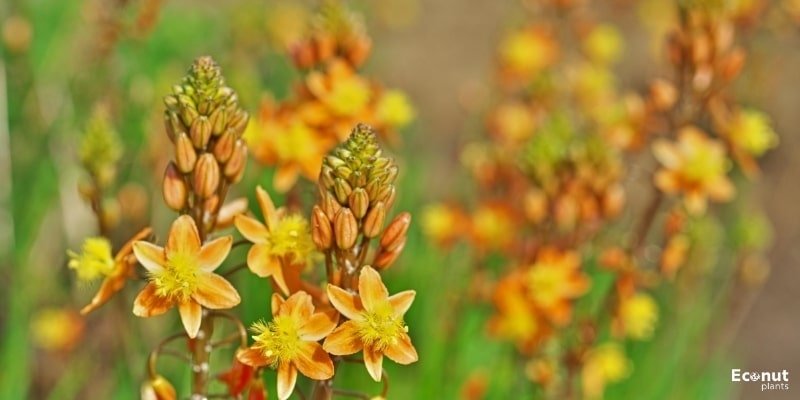
Scientific Name: Bulbine frutescens
Plant Type: Perennial
Plant Size: 2-5 feet tall
Sun Exposure: Full sun to light shade
Succulents of the bulbine kind thrive in high-moisture conditions, although this may also draw slugs, the plant’s most troublesome pest.
Although Bulbine has various variants, in general, it bears cone-shaped buds that open to produce colourful blooms with six petals. The precise cultivar you’re planting will determine when they bloom, but generally speaking, they do so at the same time that other plants are going dormant.
Although you won’t see fresh flowers every day, you will see them for the great majority of the year because the blossoms tend to last for a long time.
14. Blue Daze

Scientific Name: Evolvulus glomeratus
Plant Type: Perennial
Plant Size: 0.5-1.5 feet tall
Sun Exposure: Full sun
Autumn, spring, and summer bring forth the blooms of Blue Daze, a non-vining kind of morning glory. So, despite the fact that you won’t likely get any new blooms in the dead of winter, they should survive the season thanks to Florida’s generally moderate temperatures.
You may enjoy the half-inch blue petals on these hardy blue flowering bushes all day. On overcast days and at night, they will close.
15. Aster

Scientific Name: Symphyotrichum spp.
Plant Type: Perennial
Plant Size: 0.5-8 feet tall
Sun Exposure: Full sun to partial shade
Asters feature nearly daisy-like blossoms, each with up to twenty tiny petals encircling a vivid core.
Aster comes in a wide variety, with a variety that can be planted in nearly every type of soil. If you give your particular type of aster the proper quantity of water and sunlight, it is rather simple to cultivate.
Aster blooms come in a variety of colours, ranging from pale pink and white to deeper shades of blue. In Florida, colourful flowers can bloom year-round by combining a few different kinds.
16. Bougainvillea
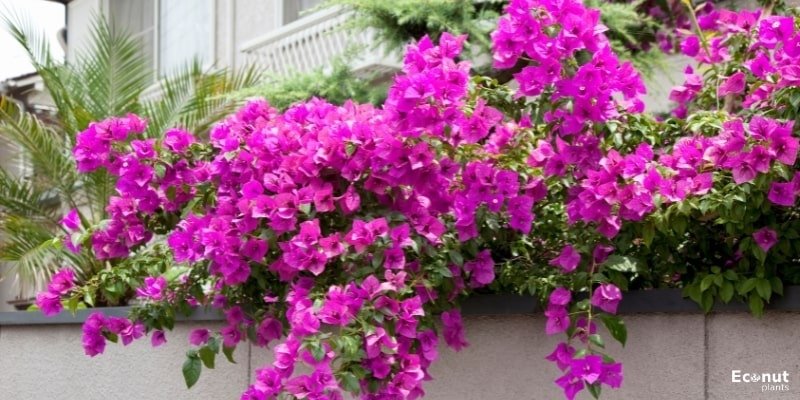
Scientific Name: Bougainvillea spp.
Plant Type: Perennial
Plant Size: 15-40 feet tall
Sun Exposure: Full sun
The shrub bougainvillaea is perfect for planting beside walls, trellises, and fence lines because its long vines can reach several feet in length. Alternatively, you could teach it to fill a container. In any case, flowers in Florida should be in bloom all year round.
The new growth vines will produce clusters of tiny white flowers in threes, encircled by vividly coloured bracts in shades of pink, purple, orange, red, yellow, and white.
17. Gerbera Daisies

Scientific Name: Gerbera jamesonii
Plant Type: Perennial / Annual
Plant Size: 1-1.5 feet tall
Sun Exposure: Full sun to part shade
Gerbera daisies are multipetaled flowers with vivid coronas in the centre, much like daisies. They have vivid shades of white, pink, orange, gold, and yellow, among other colours. They are incredibly colourful.
Some variants have white tips on their petals, some have variegated patterns, and some have contrasting centres and petals.
Although they may bloom all year in southern Florida because of the mild climate, these magnificent flowers often flourish enormously in the autumn and summer. Furthermore, you can bring these guys inside for a while in colder climates to ensure their survival until next year. They take very little upkeep overall and enjoy moist, well-draining soil.
18. Star Jasmine
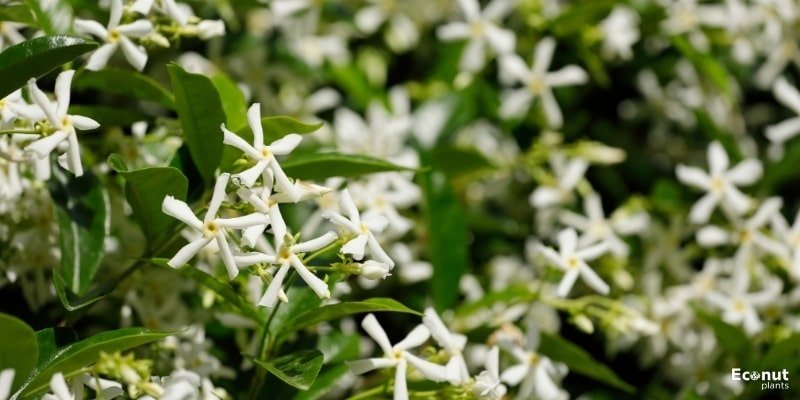
Scientific Name: Trachelospermum jasminoides
Plant Type: Perennial / Annual
Plant Size: 1.5-7 feet tall
Sun Exposure: Partial shade
This climbing plant can grow into a vine or a shrub with proper planting and pruning. It can be allowed to grow on fences, arbours, trellises, or lattices, but it also does well in pots where it can sprawl out.
It can tolerate intense cold and complete shade, but not very cold weather. The tiny white or yellow blossoms have an ultra-sweet, almost overwhelming aroma, so expect a swarm of bees to stop by for a snack.
Since the two plant groups are unrelated, star jasmine isn’t the same as true jasmine.” Be cautious and consider using the scientific name when you shop to ensure that you get the right plant.
19. Knockout Roses
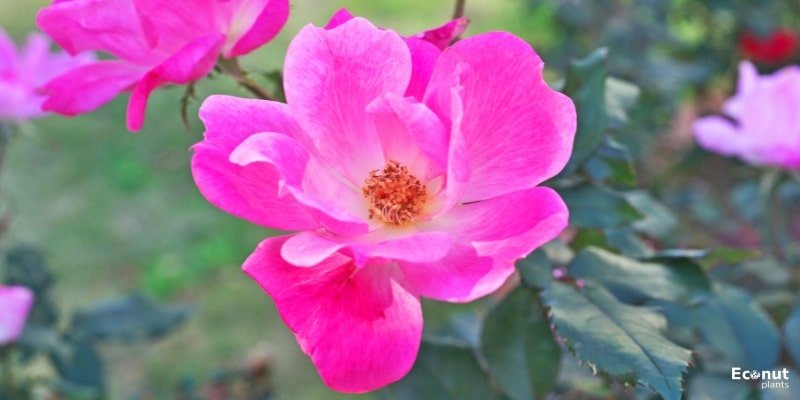
Scientific Name: Rosa “Knock Out”
Plant Type: Perennial
Plant Size: 3-10 feet tall
Sun Exposure: Full sun to partial shade
One of the most beautiful and well-liked flowering plants in the world are undoubtedly the garden rose. A lot of types only flower once or twice a season.
Some cultivars bloom more frequently, but they are climbing roses that require a lot of upkeep because they get large quickly. Recurring blooming hybrids and knockout roses are ideal for Florida’s conditions.
Thus, you can enjoy Knockout Rose blooms year-round in Florida’s normally mild climate without having to continuously trim dead wood or stake climbing vines to maintain colour.
You can also select your preferred colour because Knockout Roses come in a wide variety of variants. Try the Rosa hybrida “Radrazz” if you enjoy rich red blossoms; it thrives in humid weather.
20. Pentas

Scientific Name: Pentas lanceolata
Plant Type: Perennial
Plant Size: 1.5-2 feet tall
Sun Exposure: Part sun to full sun
The Pentas plant is a perennial that grows outside in warm areas. It has about a dozen variations.
It is a popular houseplant in colder climates where it cannot withstand the winter because of its lovely blossoms. You may observe blooms in shades of yellow, pink, purple, red (such as burgundy and crimson), and white, depending on the specific type.
21. Spurred Butterfly Pea

Scientific Name: Centrosema virginianum
Plant Type: Perennial
Plant Size: 2-7 feet tall
Sun Exposure: Full sun to partial shade
This perennial vine, known for its climbing habit, will extend procumbently across the ground in the absence of anything to cling to.
Though white blooms are sometimes conceivable, the plant mainly produces purple flowers. These flowers are usually somewhat larger than an inch when completely opened, resembling the fluttering wings of a butterfly with a pea between the halves.
You will see blooms during the warmer months, and even all year round, under the warm Florida sun. This plant is also known by its shortened name, “Butterfly Pea.”
Conclusion
Consider including one of these flowering plants in your yard if you’d like year-round blooms in Florida. Check out this enormous list of flowers, many of which can simply be planted as annuals in Florida and renewed every season, if you are still at a loss for inspiration.
You can have a stunning display of vibrant blossoms in your garden all year if the warm weather cooperates!

